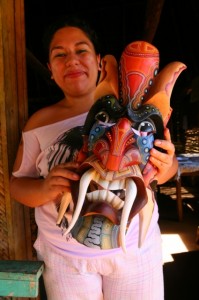
Photo © Christopher P. Baker.
When I first began researching my Moon Costa Rica handbook two decades ago, I don’t ever recall having seen Boruca masks.Today, these distinctive cultural icons are ubiquitous throughout Costa Rica, where they’re sold in virtually any souvenir store worth its salt.
One of the best I’ve ever seen is displayed proudly in my living room. Not a “mask” in the true sense, it is a three-dimensional carving hewn from balsa, in Boruca tradition, showing toucans, a jaguar, macaws, and other creatures against a forest backdrop painted in hallucinogenic detail.
I bought it at Coco Loco art gallery, at Chachagua near La Fortuna, in the Northern Lowlands, far north of the Boruca homeland.
The two thousand or so Boruca indigenous people live in the hamlet of Boruca and various other hamlets scattered throughout the Reserva Indígena Boruca, in the Fila Sinancra high above the Río Terraba valley in South Central part of Costa Rica.
Two decades ago the people were relatively unknown to the outside world, and fast-losing pride in their decaying traditional culture.
Then tourist interest was piqued by the Boruca’s annual Festival de los Diablitos (Little Devil’s Festival), which coincides with the New Year. The highlight of the festival is the Danza del los Diablitos (Dance of the Devil), performed in remembrance of the Boruca’s fierce resistance to Spanish colonization (in a twist on historical fact, the natives humiliate and defeat the Spanish).
As I write in Moon Costa Rica Handbook:
“Every year on December 30, a conch shell sounds at midnight across the dark hills of the Fila Sinancra. Men disguised as devils burst from the hills into Boruca and go from house to house, performing skits and receiving rewards of tamales and chicha, the traditional corn liquor. Drums and flutes play while villagers dressed in burlap sacks and traditional balsa-wood masks perform the Fiesta de los Diablitos. Another dresses as a bull. Plied with chicha, the diablitos chase, prod, and taunt the bull. Three days of celebrations and performances end with the symbolic killing of the bull, which is then reduced to ashes on a pyre. The festival reenacts the battles between native forebears and Spanish conquistadors with a dramatic twist: The native people win.”
When a dancer puts on a mask, he becomes possessed by its imagined spirit. He becomes the animal and the animal becomes the man, just as in the Roman Catholic tradition the sacrament becomes the body of the imagined Lord.
The newfound popularity of the festival, drawing tourists, revived interest in traditional mask-making, beginning with the famous “Devil” masks, featuring horns, bloated eyeballs, tusk-like teeth, and other grotesquely distorted features.
Boruca artisan Ismael González thus began to produce masks for sale. Others soon followed suit.
At first, the masks—carved from cedar or balsawood, and filled with tense, latent energy—were unadorned. Many are still made in this fashion, including by Ismael González, Jr., perhaps the most famous of the mask-makers working today (in 2002 he won Costa Rica’s National Culture Award). His works are so ferociously expressive and vital yet so refined they cut across barriers of culture and time.
Gradually other, less emotive, designs evolved in order to appeal to the eyes and minds of the tourist market as the local economy shifted from agriculture to tourism.
The newer masks, such as the one I own, reflect a shift toward woodcut images and are usually painted in dazzling colors.
Today’s artists live and work on the cusp between cultures, developing individual styles and creativity while honoring traditional conventions.
Two cooperatives—La Flor Cooperativa and Sô Cagrú Artisans—promote traditional crafts in Boruca village. Sô Cagrú (“masked warrior” in the local language) is a women’s cooperative headed by Marina Lázaro Morales and represents about a dozen families who still use pre-Colombian-style back-strap looms to weave hammocks, traditional shoulder-slung bags, and purses.
A tiny Museo Comunitario Boruca (tel. 506/2514-0045 or 2730-1673, 9 A.M.–4 P.M. daily, free) honors the local culture.